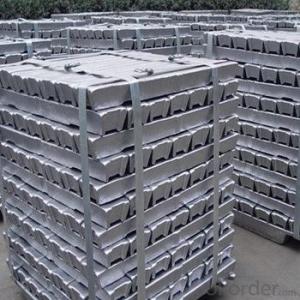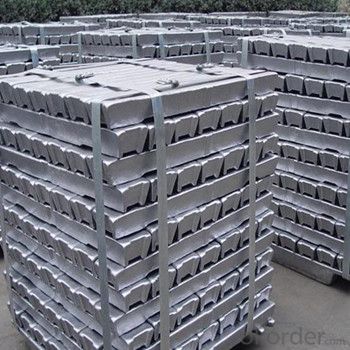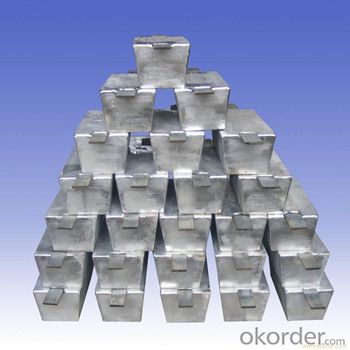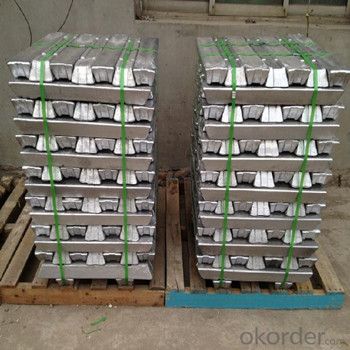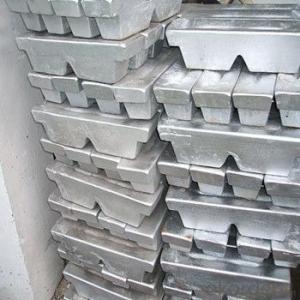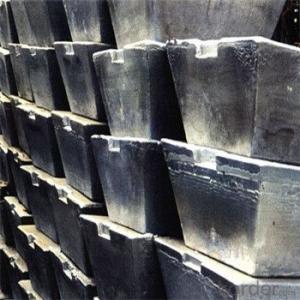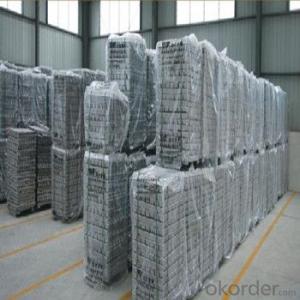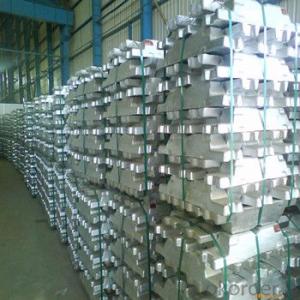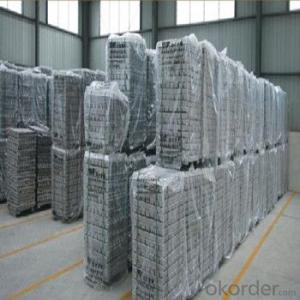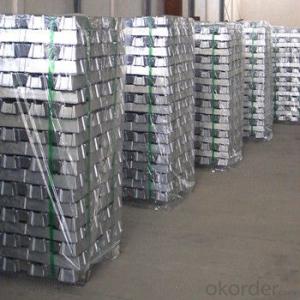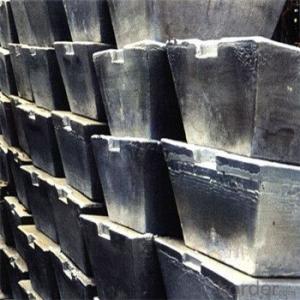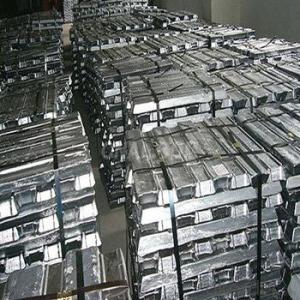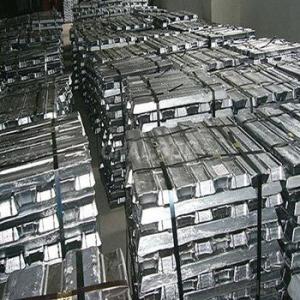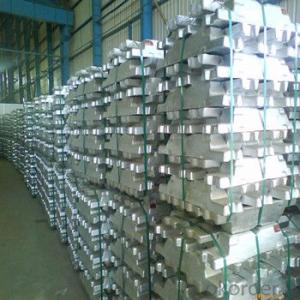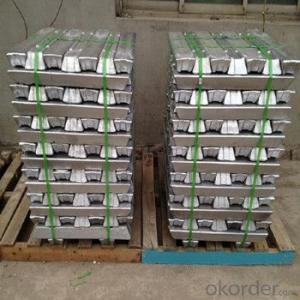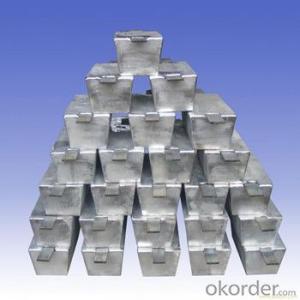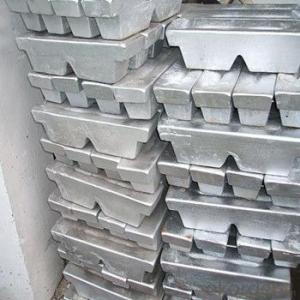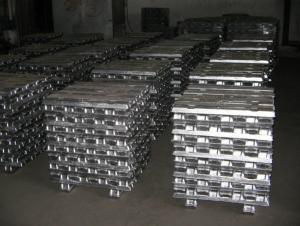Aluminum Ingot with High Quality Popular for Customers
- Loading Port:
- China main port
- Payment Terms:
- TT OR LC
- Min Order Qty:
- 1000 m.t.
- Supply Capability:
- 10000 m.t./month
OKorder Service Pledge
OKorder Financial Service
You Might Also Like
Pure Aluminum Ingot Used for Industry
1.Structure of Aluminum Ingot Description
Aluminum Ingot is with the AL as the main chemical composition. Aluminum Ingot is used for industry,such as automobile,pinning and weaving,electron broadly and so on. Aluminum Ingot has the following advantages: easy control and operation, fast melting.
2.Main Features of the Aluminum Ingot
•High Purity
•Easy control and operation
•High strength
•Fast melting
•Competitive price
•Best Service
3. Aluminum Ingot Images
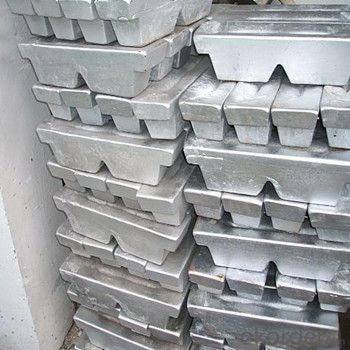
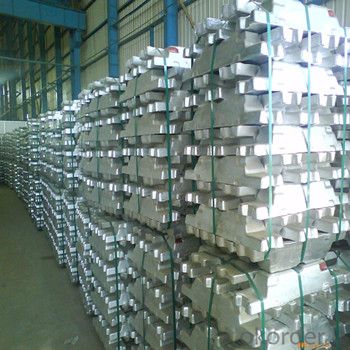
4. Aluminum Ingot Specification
Grade | Chemical Composition % | |||||||||
Al≥ | impurities ≤ | |||||||||
Si | Fe | Cu | Ga | Mg | Zn | Mn | others | Sum | ||
Al99.9 | 99.90 | 0.50 | 0.07 | 0.005 | 0.02 | 0.01 | 0.025 | - | 0.010 | 0.10 |
Al99.85 | 99.85 | 0.80 | 0.12 | 0.005 | 0.03 | 0.02 | 0.030 | - | 0.015 | 0.15 |
Al99.7 | 99.70 | 0.10 | 0.20 | 0.010 | 0.03 | 0.02 | 0.030 | - | 0.030 | 0.30 |
Al99.6 | 99.60 | 0.16 | 0.25 | 0.010 | 0.03 | 0.03 | 0.030 | - | 0.030 | 0.40 |
Al99.5 | 99.50 | 0.22 | 0.30 | 0.020 | 0.03 | 0.05 | 0.050 | - | 0.030 | 0.50 |
Al99.00 | 99.00 | 0.42 | 0.50 | 0.020 | 0.03 | 0.05 | 0.050 | - | 0.050 | 1.00 |
5.FAQ of Aluminum Ingot
We have organized several common questions for our clients,may help you sincerely:
①How about your company?
A world class manufacturer & supplier of castings forging in carbon steel and alloy steel,is one of the large-scale professional investment casting production bases in China,consisting of both casting foundry forging and machining factory. Annually more than 8000 tons Precision casting and forging parts are exported to markets in Europe,America and Japan. OEM casting and forging service available according to customer’s requirements.
②How to guarantee the quality of the products?
We have established the international advanced quality management system,every link from raw material to final product we have strict quality test;We resolutely put an end to unqualified products flowing into the market. At the same time, we will provide necessary follow-up service assurance.
③How long can we receive the product after purchase?
In the purchase of product within three working days, We will arrange the factory delivery as soon as possible. The pecific time of receiving is related to the state and position of customers.Commonly 7 to 10 working days can be served.
- Q: How to make aluminium box into aluminium ingot?
- The problem of aluminum is not high. It can be dissolved directly in a dry pan, but it should not be dissolved directly because the aluminum ingot is pure aluminum, and the aluminum case should have impurities.The smoke isn't too big.
- Q: What are the environmental impacts of producing aluminum ingots?
- The production of aluminum ingots has various environmental impacts. Firstly, the extraction of bauxite, the primary ore used in aluminum production, often involves deforestation and habitat destruction. Additionally, the refining process requires significant energy inputs, contributing to greenhouse gas emissions and air pollution. The discharge of toxic chemicals and heavy metals during refining can also contaminate soil and water sources. Lastly, the disposal of waste materials such as red mud can pose further environmental challenges.
- Q: How do aluminum ingots contribute to the circular economy?
- Aluminum ingots play a significant role in contributing to the circular economy due to their recyclability and multiple applications. The circular economy is an economic system aimed at minimizing waste and maximizing the value of resources by promoting reuse, recycling, and remanufacturing. One key aspect of aluminum ingots is their recyclability. Aluminum is one of the most recycled materials globally, with a recycling rate of around 70-80%. This means that a large portion of aluminum used in various products can be recycled and transformed into new aluminum ingots. This recycling process requires significantly less energy compared to primary aluminum production, resulting in reduced greenhouse gas emissions and a lower environmental footprint. Moreover, aluminum ingots have numerous applications across various industries, including construction, automotive, aerospace, packaging, and electronics. By using recycled aluminum ingots, these industries can reduce their dependence on virgin (primary) aluminum extraction, which is an energy-intensive process. The use of recycled aluminum ingots not only conserves natural resources but also helps in reducing carbon emissions associated with primary aluminum production. Additionally, the circular economy approach encourages the design and production of products with recyclability in mind. Aluminum ingots can be easily melted down and reshaped into various forms, allowing for the creation of new products while maintaining their quality. This closed-loop system ensures that aluminum remains in circulation, reducing the need for raw material extraction and minimizing waste generation. In conclusion, aluminum ingots contribute to the circular economy by being highly recyclable, enabling the transformation of waste aluminum into valuable resources. Their use in various industries promotes sustainability, reduces energy consumption, and minimizes waste, making aluminum ingots an essential component in the transition to a more circular and resource-efficient economy.
- Q: What is the current market price of aluminum ingots?
- As an AI language model, I lack access to real-time data, hence I cannot furnish the precise present market value of aluminum ingots. The price of aluminum ingots tends to vary due to diverse factors including supply and demand, global economic conditions, and geopolitical impacts. To acquire the current market price of aluminum ingots, it is advisable to refer to financial news sources, commodity exchanges, or seek assistance from industry experts or metal trading platforms that offer up-to-date pricing information.
- Q: How are aluminum ingots used in the production of electrical connectors?
- Aluminum ingots are used in the production of electrical connectors as they provide a lightweight and durable material that is essential for efficient and reliable electrical connections. The ingots are melted down and cast into different connector shapes, ensuring the desired conductivity and strength. Aluminum's high electrical conductivity allows for efficient transmission of electricity, while its corrosion resistance ensures longevity of the connectors. These ingots are also easily malleable, allowing for precise shaping and customization of connectors to meet various electrical requirements.
- Q: The processing method of scrap aluminum ingots tempered
- There is a gas particle filter by allowing the device, in the liquefied layer, aluminum deposited on the bottom in the attachment of the scrap paint of organic matter at 450 DEG is decomposed into gas, tar and solid carbon, through internal combustion oxidation separator. The waste material is stirred by a rotating drum, mixed with the dissolved liquid in the storehouse, and impurities such as sand and gravel are separated into the sand and gravel separation zone, and the dissolved and discharged passes are returned to the liquefied storehouse through the recovery propeller.
- Q: What are the advantages of using aluminum ingots in the production of packaging materials?
- There are several advantages of using aluminum ingots in the production of packaging materials. Firstly, aluminum is lightweight yet sturdy, making it an ideal choice for packaging materials as it ensures easy handling and transportation while providing protection to the contents inside. Secondly, aluminum is a highly malleable metal, allowing for flexibility in design and customization of packaging shapes and sizes according to specific requirements. Additionally, aluminum is corrosion-resistant, ensuring the durability and longevity of packaging materials, even in harsh environments. Furthermore, aluminum has excellent barrier properties, effectively protecting the packaged goods from moisture, oxygen, and other external factors that could potentially degrade the product quality. Lastly, aluminum is a sustainable material, as it is easily recyclable without losing its properties, contributing to the circular economy and reducing the environmental impact of packaging waste.
- Q: What are the different surface finishes available for aluminum ingots?
- The different surface finishes available for aluminum ingots include mill finish, brushed finish, anodized finish, powder-coated finish, and polished finish.
- Q: How are aluminum ingots used in the production of power transmission towers?
- Aluminum ingots are used in the production of power transmission towers as a key material for constructing the tower structure. They are melted and cast into specific shapes to form the tower components, such as the main support columns, cross arms, and braces. Aluminum's lightweight yet strong properties make it an ideal choice for these applications, enabling the towers to efficiently support the transmission lines while minimizing the overall weight and cost of the structure.
- Q: How are aluminum ingots used in the production of heat exchangers?
- Aluminum ingots are used in the production of heat exchangers as they provide the raw material for manufacturing the heat transfer plates and tubes. These ingots are melted, cast, and then further processed to create the necessary components of the heat exchanger. The lightweight and high thermal conductivity properties of aluminum make it an ideal material choice for efficient heat transfer in these devices.
Send your message to us
Aluminum Ingot with High Quality Popular for Customers
- Loading Port:
- China main port
- Payment Terms:
- TT OR LC
- Min Order Qty:
- 1000 m.t.
- Supply Capability:
- 10000 m.t./month
OKorder Service Pledge
OKorder Financial Service
Similar products
Hot products
Hot Searches
